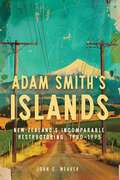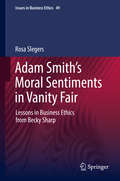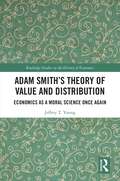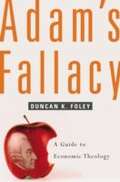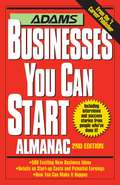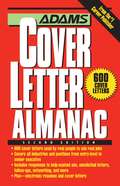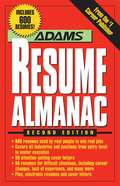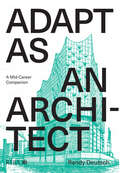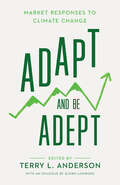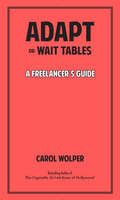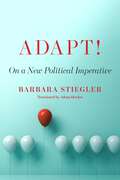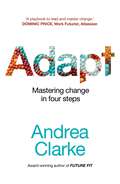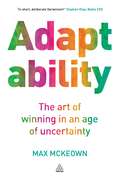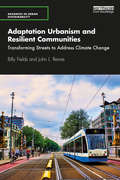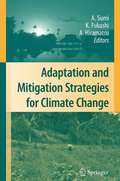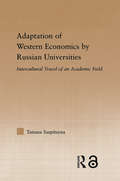- Table View
- List View
Adam Smith’s Islands: New Zealand’s Incomparable Restructuring, 1980–1995
by John C. WeaverMany developed countries restructured relations between state and economy from the late 1970s into the 1990s. Among them, New Zealand went far, fast, and left a clear trail, making it possible to study economic restructuring as it occurred, with all the debates, uncertainty, surprises, mistakes, and accomplishments this entailed. Adam Smith’s Islands reveals the inside life of a government determined to revolutionize its nation’s politics and economy.While the 1980s economic restructuring of members of the Organisation for Economic Co-operation and Development and former Warsaw Pact countries can seem like a foregone conclusion from the vantage point of the twenty-first century, John Weaver examines how local and global institutions had to come together to implement social adjustments in New Zealand. Mounting evidence that the state had not functioned as an effective manager split the business community and primary producers between defenders of subsidization and free-market insurgents. Reforms undertaken by the governing Labour Party included abandoning currency controls, privatizing state-run businesses, ending a multitude of open and disguised subsidies, tightening fiscal responsibility, and reforming taxation. Adam Smith’s Islands focuses on the verifiable: direct primary sources from dozens of state collections and deposits of personal papers. The archival cornucopia informing this history supports a narrative that has little in common with intellectual histories of neoliberalism. To understand how the relationship between the economy and the state changed, we need to grasp how and why core institutions, practices, and cultural beliefs shed some of their once potent legitimacy.Through the lens of New Zealand, Adam Smith’s Islands examines larger questions about policy dilemmas, the global flow of capital, and the sustainability of social adjustments in economic restructuring. In so doing, it casts new light on the formation and history of what is casually labelled today as the neoliberal state.
Adam Smith’s Moral Sentiments in Vanity Fair: Lessons in Business Ethics from Becky Sharp (Issues in Business Ethics #49)
by Rosa SlegersAccording to Adam Smith, vanity is a vice that contains a promise: a vain person is much more likely than a person with low self-esteem to accomplish great things. Problematic as it may be from a moral perspective, vanity makes a person more likely to succeed in business, politics and other public pursuits. “The great secret of education,” Smith writes, “is to direct vanity to proper objects:” this peculiar vice can serve as a stepping-stone to virtue. How can this transformation be accomplished and what might go wrong along the way? What exactly is vanity and how does it factor into our personal and professional lives, for better and for worse?This book brings Smith’s Theory of Moral Sentiments into conversation with William Makepeace Thackeray’s Vanity Fair to offer an analysis of vanity and the objects (proper and otherwise) to which it may be directed. Leading the way through the literary case study presented here is Becky Sharp, the ambitious and cunning protagonist of Thackeray’s novel. Becky is joined by a number of other 19th Century literary heroines – drawn from the novels of Jane Austen, Charlotte Brontë and George Eliot – whose feminine (and feminist) perspectives complement Smith’s astute observations and complicate his account of vanity. The fictional characters featured in this volume enrich and deepen our understanding of Smith’s work and disclose parts of our own experience in a fresh way, revealing the dark and at times ridiculous aspects of life in Vanity Fair, today as in the past.
Adam Smith’s System: A Re-Interpretation Inspired by Smith's Lectures on Rhetoric, Game Theory, and Conjectural History (Palgrave Studies in the History of Economic Thought)
by Andreas Ortmann Benoît WalraevensInspired by his lectures on rhetoric and by game theory, this book provides a new interpretation of Adam Smith’s system of thought. It highlights its coherence through the identification of three reasoning routines and a meta-reasoning routine throughout his work on languages, rhetoric, moral sentiments, self-command, and the nature and causes of the wealth of nations. The identification of these reasoning routines allows the authors to uncover a hitherto poorly understood deep structure of Smith’s work and to explain its main characteristics. How these routines emerged in Smith’s early research on the principles of the human mind is also traced. This book sheds new light on Adam Smith and his work, highlighting his sophisticated understanding of strategic interaction in all things rhetorical, moral, and economic. It will be relevant to students and researchers interested in the history of ideas, the history of economic thought, game theory, Enlightenment studies, and rhetoric.
Adam Smith’s Theory of Value and Distribution: Economics as a Moral Science Once Again (Routledge Studies in the History of Economics)
by Jeffrey T. YoungEver since the time of his early interpreters, beginning with David Hume, Adam Smith’s theory of value has been the subject of confusion and misunderstanding – including a controversy which still rages over whether Smith held a labour theory of value, and, if so, whether he held to it throughout Wealth of Nations, or if it was confined to the “Early and Rude State”? This book provides a close reading of Smith’s key text, and also incorporates material from the other parts of Smith’s oeuvre, especially from The Theory of Moral Sentiments, to yield original and important insights into Smith’s theory of value. The book operates on the assumption that Smith is proposing relatively simple ideas about price and takes a conventional view that simple Supply and Demand models can illuminate, clearly and consistently with his text, his theory of price. Combining these elements, the book argues that, contra Marx, Smith does not have a labour theory of value at all, understood as a theory of the determination of the relative price structure. Instead, Smith is placed squarely in the supply and demand, general equilibrium framework and the claim that he is part of a “surplus tradition”, which receives its highest treatment in the work of Piero Sraffa, is refuted. This book will be of particular interest to Adam Smith specialists, historians of economic thought, and research economists who have an interest in Smith.
Adam Smith’s Wealth of Nations
by Jerry EvenskyAdam Smith's The Wealth of Nations is regarded by many as the most important text in the history of economics. Jerry Evensky's analysis of this landmark book walks the reader through the five 'Books' of The Wealth of Nations, analyzing Smith's terms and assumptions and how they are developed into statements about economic processes in Book I, his representation of the dynamics of economics systems in Book II, and his empirical case for his model in Book III. With that framework in place, Evensky examines Smith's critique of alternative models, mercantilism and physiocracy, in Book IV, and Smith's presentation of the policy implications of his analysis presented in Book V. This guide highlights the nexus of Smith's economics and his work on ethics and jurisprudence, and in doing so Evensky sets his examination of The Wealth of Nations into a larger, holistic analysis of Smith's moral philosophy.
Adam's Fallacy: A Guide to Economic Theology
by Duncan K. FoleyThis book could be called "The Intelligent Person's Guide to Economics." The title expresses Duncan Foley's belief that economics at its most abstract and interesting level is a speculative philosophical discourse, not a deductive or inductive science. Adam's fallacy is the attempt to separate the economic sphere of life, in which the pursuit of self-interest is led by the invisible hand of the market to a socially beneficial outcome, from the rest of social life, in which the pursuit of self-interest is morally problematic and has to be weighed against other ends.
Adams Businesses You Can Start Almanac
by Adams Media500 businesses you can start!The time to start your own business is now! Whether you're a previously employed manager seeking new opportunities and greater job satisfaction, starting up a home-based business, re-entering the job market, or just looking to earn some extra cash on the side, this book helps you discover the business that's just right for you.This detailed reference provides more than 500 different business opportunities to choose from. Each entry features:A description of the businessStart-up and hidden costsPotential earningsQualifications and equipment neededMarketing and advertising tips for the best resultsIn addition, this book contains critical advice on:Creating a business planSurvival strategiesLegal considerationsLong-term growth strategiesNo matter what your criteria-start-up costs, skill sets, professional and personal interests-the Adams Businesses You Can Start Almanac, 2nd Edition prepares you to take the most exciting step of your career-being your own boss!
Adams Capital Management: Fund IV
by Josh Lerner G. Felda Hardymon Ann LeamonThe partners of Adams Capital Management must decide whether to start their fourth fund in early 2006 or to hold off until they have realized more exits from the earlier funds and have proved the viability of a recent change in strategy.
Adams Capital Management: March 2002
by Josh Lerner G. Felda Hardymon Ann LeamonIn March 2002, the five partners of Adams Capital Management (ACM), a venture capital firm investing in information technology telecommunications with $700 million under management, gathered to discuss whether they should change their strategy in view of the prolonged downturn in both the economy and their targeted investment sectors. Since its founding in 1993, ACM had followed a distinct strategy of targeting particular markets of interest, investing within these, and managing the portfolio companies through a defined process to liquidity. ACM's first fund had performed extremely well; its second was looking good; and the third, albeit only a year into its life, was not performing as well. ACM is considering three options: investing in companies producing more fundamental products, hiring more associates or investing in more markets, or taking bigger positions in companies in its traditional sectors. Each has its own possibilities and drawbacks. A rewritten version of an earlier case.
Adams Cover Letter Almanac: Second Edition
by Richard J WallaceA sure cure to job-seeker’s writer’s block!The Adams Cover Letter Almanac, Second Edition is the most comprehensive guide available for creating an attention-getting cover letter. This easy-to-use volume is packed with sample cover letters that can be easily customized to match the needs of any job seeker, whether you’re new to the job market, an experienced professional, changing careers, or reentering the workforce. BEAT THE COMPETITION A good cover letter can be even more important than a resume. If a prospective employer isn’t impressed by your cover letter, you won’t get that interview no matter how polished your resume is. Yet, many job seekers put little time or thought into their cover letters, often sending the same tired form letter to hundreds of companies. The Adams Cover Letter Almanac, Second Edition gives you an edge on the competition by helping you create powerful, compelling letters that get you noticed. 600 COVER LETTERS Based on professionally written cover letters that have landed real jobs, sample letters are included for every occasion: -Response to an Online Advertisement -Response to a Classified Advertisement -Response to a “Blind” Advertisement -“Cold” Letter to a Potential Employer -Letter to an Employment Agency -Broadcast Letter -Cover Letters for Special Occasions -Follow-Up Letter LETTERS FOR ALL CAREERS AND ALL LEVELS Whether you’ve recently graduated or are a seasoned executive, you’ll find letters for numerous positions including: -Accounting and Finance -Marketing and Sales -Communications -Management -Computers and Engineering -Science -Education -Social and Human Services -Health and Medical -Technical -Legal and Protective Services -And more! Other Adams Almanacs for Job Hunters Include: Adams Resume Almanac, Second Edition Adams Job Interview Almanac, Second Edition Adams Internet Job Search Almanac, Sixth Edition
Adams Resume Almanac
by Adams MediaA must for the successful job search, The Adams Resume Almanac, 2nd Edition contains everything a candidate needs to know in order to craft a compelling, job-winning resume. Whether a first-time job hunter starting with a blank page, or a seasoned professional with a long story to tell, the candidate will find 600 examples of resumes appropriate to every situation.
Adams Resume Almanac
by Richard J WallaceA revised edition of the most comprehensive resume guide on the market! A must for the successful job search, The Adams Resume Almanac, 2nd Edition contains everything a candidate needs to know in order to craft a compelling, job-winning resume. Whether a first-time job hunter starting with a blank page, or a seasoned professional with a long story to tell, the candidate will find 600 examples of resumes appropriate to every situation.
Adams Resume Almanac
by Richard WallaceA revised edition of the most comprehensive resume guide on the market! A must for the successful job search, The Adams Resume Almanac, 2nd Edition contains everything a candidate needs to know in order to craft a compelling, job-winning resume. Whether a first-time job hunter starting with a blank page, or a seasoned professional with a long story to tell, the candidate will find 600 examples of resumes appropriate to every situation.
Adam’s Fallacy: A Guide to Economic Theology
by Duncan K. FoleyThis book could be called “The Intelligent Person’s Guide to Economics.” Like Robert Heilbroner’s The Worldly Philosophers, it attempts to explain the core ideas of the great economists, beginning with Adam Smith and ending with Joseph Schumpeter. In between are chapters on Thomas Malthus, David Ricardo, Karl Marx, the marginalists, John Maynard Keynes, Friedrich Hayek, and Thorstein Veblen. The title expresses Duncan Foley’s belief that economics at its most abstract and interesting level is a speculative philosophical discourse, not a deductive or inductive science. Adam’s fallacy is the attempt to separate the economic sphere of life, in which the pursuit of self-interest is led by the invisible hand of the market to a socially beneficial outcome, from the rest of social life, in which the pursuit of self-interest is morally problematic and has to be weighed against other ends. Smith and his successors argued that the market and the division of labor that is fostered by it result in tremendous gains in productivity, which lead to a higher standard of living. Yet the market does not address the problem of distribution—that is, how is the gain in wealth to be divided among the classes and members of society? Nor does it address such problems as the long-run well-being of the planet. Adam’s Fallacy is beautifully written and contains interesting observations and insights on almost every page. It will engage the reader’s thoughts and feelings on the deepest level.
Adapt As An Architect: A Mid-Career Companion
by Randy DeutschAdapt As An Architect: A Mid-Career Companion is the only book that helps design professionals to navigate the vast heart of the architect’s journey. It serves as a roadmap: a career GPS that provides options for architects getting from where they are today to where they really want to be. The focus of this optimistic, engaging book is on continued relevance, professional engagement, perseverance, and career longevity. It argues that mid-career is the lynchpin of the architect’s career, and provides the guidance and support that practices themselves are missing for emerging professionals, who are often left to their own devices to find their way as they approach the middle of their career. This book means architects don’t need to navigate these years on their own.
Adapt and Be Adept: Market Responses to Climate Change
by Terry L. AndersonHow can markets help us adapt to the challenges of climate change? Editor Terry L. Anderson brings together this collection of essays featuring the work of nine leading policy analysts, who argue that market forces are just as important as government regulation in shaping climate policy—and should be at the heart of our response to helping societies adapt to climate change.Anderson notes in his introduction that most current climate policies such as the Paris Agreement require hard-to-enforce collective action and focus on reducing or mitigating greenhouse gases rather than adapting to their negative effects. Adaptive actions can typically deliver much more, faster and more cheaply than any realistic climate policy. The authors tackle a range of issues: the hidden costs of renewable energy sources, the political obstacles surrounding climate change policy, insurance and financial instruments for pricing risk of exposure to the effects of climate change, and more.Reliance on emerging renewable energies and a carbon tax are not enough to prevent the effects of global warming, they argue. We must encourage more private action and market incentives to adapt to a rapidly changing climate.
Adapt or Wait Tables
by Carol WolperInability to adapt is the new illiteracy and freelancing is becoming America's new normal. What 2008 taught America was not just that derivatives are dangerous and the housing market doesn't rise forever. It also taught us that survival requires juggling and pivoting, two skills that any freelancer is forced to acquire if they want to keep paying their rent. Adapt or Die is a mix of information, tricks and advice for all the freelancers out there, and the ones who will be stepping onto that playing field as they graduate from college. Written by a freelance writer who has spent the past two decades covering Hollywood and the world of pop culture and fashion, their tips for survival are laced with gossip and references to the famous as well as what they call the "secret celebrities" whose paths they have crossed. Consider this an entertaining how-to manual for anyone with ambition and no road map.
Adapt the Master Brand to Silo Markets: Developing a Master Brand Strategy
by David AakerStandardizing the brand and supporting marketing programs across all silos of an organization facilitates consistency in look, feel, and message. In addition, the chances of creating synergistic marketing programs will be enhanced, and the organization will be more likely to rally around the brand promise. However, there are situations in which a standardized brand is not optimal or even feasible because it cannot deliver a winning position in a silo market. In that case, there needs to be a process to adapt a master brand so that it has traction in each silo market while maintaining consistency to its core values.
Adapt!: On a New Political Imperative
by Barbara StieglerWinner, French Voices AwardThis book, a crossover hit in France, offers a fresh genealogy of our neoliberal moment.“We must adapt!” These words can be heard almost everywhere and in every aspect of our lives. Where does this widespread sense that we have fallen behind come from? How can we explain this progressive colonization of the economic, social, and political fields by this biological vocabulary of evolution? Offering a lucid account of sophisticated material, Barbara Stiegler uncovers the prehistories of today’s ubiquitous rhetoric in Darwinism and American liberalism, while, at the same time, recovering powerful resistances to the rhetoric of adaptation across the twentieth century.Walter Lippmann, an American theorist of this new liberalism, believed democracy was not adapted to the needs of globalization. Only a government of experts could force society to evolve, he argued. Lippmann thus found himself confronted with John Dewey, the great figure of American Pragmatism. Both Lippmann and Dewey labored under the impression that the world had changed and society needed to adapt. However, Lippmann did not trust society to adapt on its own and insisted on the need for experts who would force the necessary adaptation. Dewey, by contrast, believed the necessary adaptation could only come "from below" and should proceed in a democratic fashion. Focusing on readings of Michel Foucault, Walter Lippmann, and John Dewey, Adapt! paves the way for renewed insights into neoliberalism’s history, essence, characteristic forces, and impacts, as well as biopolitical theory. Stiegler presents an intriguing new genealogy for the development of neoliberalism, examining whether humans are by nature lagging and require biopolitical and disciplinary management to enforce adaptation. Stiegler also reorients Foucault’s genealogy of neoliberalism by emphasizing the Darwinian rhetoric of adaptation, as it arose in the Lippmann–Dewey Debate, and deftly handles the question of human nature in a way that re-enlivens this traditional concept. As the industrialization of our ways of life never stops destroying the environment and the health of organisms (climate disruption, the destruction of biodiversity, the growth of chronic diseases, the return of large pandemics), how can we think of a democratic government of life and the living? This is the question that Stiegler’s work helps us to confront.
Adapt: Mastering change in four steps
by Andrea ClarkeTransform your life and your career with the four steps to adapt effectively to change: Engage, Accept, Activate, Release. &‘A powerful playbook to lead change.&’ Dominic Price, Atlassian After the global pause in 2020, we returned to a world that feels faster, looser, and less structured – our professional boundaries have been erased, social and cultural norms are shifting rapidly, and at the same time, we're facing profound developments in artificial intelligence. We're facing more change more often, yet we're applying a mindset that is outdated and no longer fit-for-purpose.Adapt offers a fresh perspective. Andrea Clarke, the award-winning author of Future Fit, argues that rather than retreat from change or resist it, we must engage with it continuously and learn how to anticipate and shape it. She will teach you practical tools, including how to scan for signals of change to minimise disruption, apply the good advice test to make better decisions, use the 80/20 rule to explore unseen opportunities, and protect your health with the energy curve. Whether you&’re striving to be a better leader, or seeking more control over your life, Adapt will equip you with a new way to master change in an unpredictable world. This book reframes change as a powerful tool for growth, opportunity and meaningful progress.
Adaptability
by Max MckeownAll success is successful adaptation. All failure is a failure to adapt. Adaptability is about the powerful difference between adapting to cope and adapting to win. Fascinating real-world examples from business, government, and sport, military and wider society bring the rules of adaptability to life. From the world's most innovation corporations to street-level creativity emerging from the slums. From McDonalds to Sony, from post-war Iraq to the revolutions of the Arab Spring, from the bustling markets of Hong Kong to the rubber marked circuit of the Monte Carlo Rally. With insightful rules, Max Mckeown shows you how to increase the adaptability of your organization to create winning positions. Human history is a story of competition to adapt between groups and individuals. It has never been more important to understand how to think better and adapt.
Adaptable Architecture: Theory and practice
by Robert Schmidt III Simon AustinAdaptable Architecture provides thought-provoking and inquisitive insights into how we can prolong the useful life of buildings by designing them to be more adaptable, and hence create a more sustainable built environment. The book provides a theoretical foundation counterpointed by the experiences and ideas of those involved in the design and use of buildings. It explains many approaches to designing for change, with lessons from history, and case studies including The Cedar Rapids Public Library, Kentish Town Health Centre and Folkestone Performing Arts Centre, which stretch our thinking beyond the conventional notions of adaptability. The authors reveal the many conditions that make it a complex design phenomenon, by considering the purpose, design and business case of buildings as well as the physical product. Full of summaries, diagrams, reference charts, tables, and photos of exemplar solutions for use as conversational tools or working aids, this book is for any professional or student who wants to research, question, imagine, illustrate - and ultimately design for - adaptation. In addition, further information and resources are available through the Adaptable Futures website www.adaptablefutures.com which includes additional case studies, videos, information about industry events and up-to-the-minute developments.
Adaptation Urbanism and Resilient Communities: Transforming Streets to Address Climate Change (Advances in Urban Sustainability)
by John L. Renne Billy FieldsAdaptation Urbanism and Resilient Communities outlines and explains adaptation urbanism as a theoretical framework for understanding and evaluating resilience projects in cities and relates it to pressing contemporary policy issues related to urban climate change mitigation and adaptation. Through a series of detailed case studies, this book uncovers the promise and tensions of a new wave of resilient communities in Europe (Copenhagen, Rotterdam, and London), and the United States (New Orleans and South Florida). In addition, best practice projects in Amsterdam, Barcelona, Delft, Utrecht, and Vancouver are examined. The authors highlight how these communities are reinventing the role of streets and connecting public spaces in adapting to and mitigating climate change through green/blue infrastructure planning, maintaining and enhancing sustainable transportation options, and struggling to ensure equitable development for all residents. The case studies demonstrate that while there are some more universal aspects to encouraging adaptation urbanism, there are also important local characteristics that need to be both acknowledged and celebrated to help local communities thrive in the era of climate change. The book also provides key policy lessons and a roadmap for future research in adaptation urbanism. Advancing resilience policy discourse through multidisciplinary framework this work will be of great interest to students of urban planning, geography, transportation, landscape architecture, and environmental studies, as well as resilience practitioners around the world.
Adaptation and Mitigation Strategies for Climate Change
by Ai Hiramatsu Kensuke Fukushi Akimasa SumiIn recent decades there has been a growing awareness of how intricate the interactions are between human beings and the environment. Fortunately, progress has been made in understanding this relationship, and new technologies have been effective in addressing environmental problems. However belatedly, there has been an acknowledgment of the incompatibility of the world's finite resources with humankind's increasingly greater needs for them, and of how such a challenge demands broadened collaboration among engineers, social scientists, politicians and financial powers. Global agreement that the essential issues of the twenty-first century cannot be solved by any one discipline has led to the concept of sustainability. The transdisciplinary contributions selected for inclusion in this book address these concerns with an overview of the diverse fields of study related to sustainability. This collection of work is intended to pave the way for further collaboration among scientists and nations as well.
Adaptation of Western Economics by Russian Universities: Intercultural Travel of an Academic Field (Studies In Higher Education)
by Tatiana SuspitsynaFirst published in 2005. Routledge is an imprint of Taylor & Francis, an informa company.
